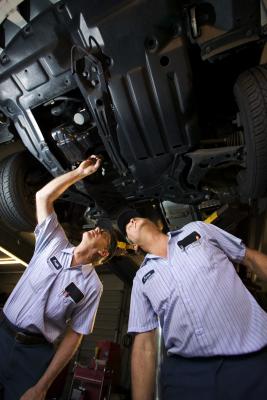
Since the first fully automatic transmission appeared in the 1948 Oldsmobile, technology has transformed transmissions into computer-controlled units that provide the highest level of efficiency. Today's automatic transmission technology includes planetary gear sets, hydraulic systems and electrical systems. A properly functioning automatic transmission provides drivers with smooth, effortless shifting through the full range of operating conditions.
An important reason for the smooth operation of an automatic transmission is the planetary gear set. The planetary gear set includes a sun gear, a ring gear and planet gears. Each gear is in mesh with all of the other gears in the set at all times, and a carrier provides the means to attach each gear to a pinion. The input shaft from the engine is connected to the ring gears, which pass power through the planetary gears to the sun gear and out through the output shaft.
The hydraulic system in your transmission consists of a pump, passages and tubes that send fluid throughout every component in the transmission. Transmission fluid enables shifting, provides lubrication and cools your transmission. The heart of the hydraulic system is the oil pump, which is separate from the pump in the torque converter. For the hydraulic system to work properly, fluid must pass throughout the transmission under pressure. Solenoids use fluid pressure to engage the clutches and gears that transfer power to the drive wheels.
The transmission’s electrical system uses wiring, switches, solenoids and sensors to control how the transmission shifts in response to driver inputs and engine operating conditions. Electronic transmission control has allowed manufacturers to eliminate cumbersome shift linkage, allowing for innovative vehicle design. Newer computerized transmissions use stored driver inputs to tailor shift points and performance characteristics to enhance transmission operation. Computerized transmissions have self-diagnostic capabilities that allow technicians to quickly diagnose issues. When the system detects a fault, an indicator will illuminate on the instrument panel.
The governor, vacuum modulator and throttle linkage are important components in older transmissions. The governor is attached to the output shaft and uses centrifugal force to control weights that regulate fluid pressure. The vacuum modulator uses vacuum from the engine to control shift points in relationship to driver demand and engine load. Some transmissions use a throttle linkage from the carburetor to accomplish the same tasks the vacuum modulator would accomplish. The throttle cable connection allows the transmission to be responsive to driver demands.